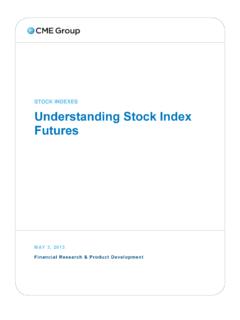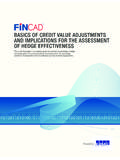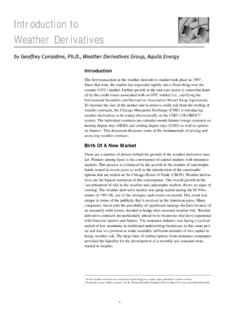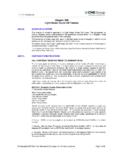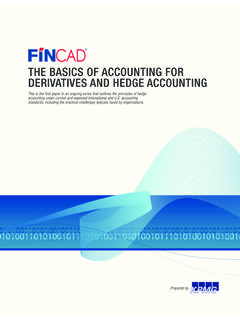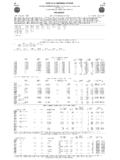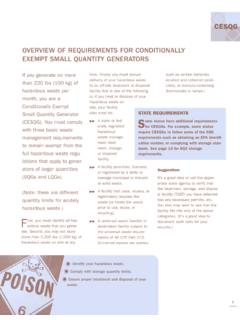Transcription of Speculative Position Limits and Hedge Exemptions - CME …
1 Speculative Position Limits and Hedge Exemptions Fred Seamon, Associate Director Research & Product Development 312-634-1587, The Commodity Futures Trading Commission (CFTC) Regulation establishes Speculative Position Limits for named agricultural contracts that are traded on specifically identified markets. Regulation simply sets forth how many contracts a speculator may hold, long or short, in each of these contract markets for futures and options combined. For Chicago Board of Trade agricultural products, those Limits are currently set forth as follows: Speculative Position Limits [By contract] Contract Spot Month Single Month All Months Combined Corn 600 13,500 22,000 Oats 600 1,400 2,000 Soybeans 600 6,500 10,000 Wheat 600 5,000 6.
2 500 Soybean Oil 540 5,000 6,500 Soybean Meal 720 5,000 6,500 Spot Month Limits Spot month Limits restrict how many contracts a speculator can hold in a contract month that is entering or has entered its delivery cycle. For example, sellers may give their intention to deliver against corn futures contracts two business days prior to the delivery month. For the July 2008 Corn futures contract that recently went into delivery that date was June 27, 2008. Thus, all speculators in the corn futures market could hold no more than 600 net long or net short positions in the July 2008 Corn futures contract at the close of business on June 27th. Speculative Position Limits and Hedge Exemptions Page 2 of 5 Spot month Speculative Position Limits are based on the deliverable supply of the commodity at the futures delivery point and may be no greater than one-quarter of the estimated deliverable supply at the futures delivery points.
3 For example, if the minimum monthly deliverable supply over an entire crop year at all corn futures delivery points is 12 million bushels, one-quarter of this amount is 3 million bushels. Since each corn futures contract represents 5,000 bushels, the corn spot month Speculative limit would be 3 million divided by 5,000 or 600 contracts. Single Month and All Months Combined Limits The CFTC also establishes single month and all months combined Speculative Limits . Single month Limits indicate the maximum number of net long or net short positions a speculator may hold in one non-spot contract. For example, a speculator can hold no more than 6,500 contracts net long or net short in any single soybean futures and/or options contract month that has not entered its delivery cycle. All month Limits establish the maximum number of positions a speculator can hold in all trading months including the spot month.
4 In soybeans, for example, a speculator may hold no more than 10,000 contracts net long or short in all soybean futures and options contract months combined. The available contract months for soybeans are November, January, March, May, July, August and September, which span multiple contract years. Single month and all month Limits are established by a formula. This formula allows single and all month Limits to be no more than 10% of the average combined futures and delta-adjusted option month-end open interest for the most recent calendar year up to 25,000 contracts with a marginal increase of of the remaining open interest thereafter. For example, assume a particular futures contract s average month-end open interest over the previous year was 200,000 contracts. The single and all month Speculative limit formula would allow 10 percent of the first 25,000 contracts or 2,500 contracts.
5 The formula allows an additional percent over the remaining 175,000 contracts or 4,375 contracts. In this example, the maximum allowable single and all month Speculative Limits for this contract would be 2,500 + 4,375 = 6,875 contracts. As a contract grows, the formula allows larger single month and all month Speculative Limits . However, spot month Speculative Limits are determined by the amount of physical commodity that is deliverable. Despite significant growth in all CBOT agricultural futures contracts, single and all month Speculative Limits have not increased since December 2005. Thus, the CBOT agricultural markets are operating under Speculative Limits significantly below what would be allowed should the CFTC single and all months formula be applied to 2007 data. The following table details the levels of single month and all month Speculative Limits for the CBOT agricultural products.
6 Spot month Limits have not increased since prior to 1999. Speculative Position Limits and Hedge Exemptions Page 3 of 5 Historical Speculative Position Limits [By contract] Single Month Limits Contract Prior July 99 July 99 - July 05 July 05 - Dec 05 Post Dec 051 Corn 3,400 5,500 9,500 13,500 Oats 900 1,000 1,200 1,400 Soybeans 2,400 3,500 5,000 6.
7 500 Wheat 2,100 3,000 4,000 5,000 Soybean Oil 2,000 3,000 4,000 5,000 Soybean Meal 2,200 3,000 4,000 5,000 All Months Combined Prior July 99 July 99 - July 05 July 05 - Dec 05 Post Dec 051 Corn 5,000 9,000 15,500 22,000 Oats 1,200 1,500 1,750 2,000 Soybeans 4,000 5,500 7,750 10,000 Wheat 3,200 4,000 5,250 6,500 Soybean Oil 3,100 4,000 5,250 6,500 Soybean Meal 3,400 4,000 5,250 6,500 1 These are current Speculative Position Limits that are in effect for these contract markets.
8 Hedge Exemptions All traders in the above futures contracts are subject to these Speculative Position Limits unless they apply for and receive a Hedge exemption . Participants who can demonstrate that their futures positions are bona fide hedging transactions may apply to the CFTC and to the Exchange to receive an exemption from Speculative Position Limits and, if the exemption is granted, may hold positions in excess of these Limits . Regulation lists positions that may be exempted from (and thus exceed) the Federal Limits : Bona fide hedging transactions which are defined in CFTC (z) as transactions that normally represent a substitute for transactions to be made, or positions to be taken, at a later time in a physical marketing channel and that are economically appropriate to the reduction of risks in the conduct of a commercial enterprise.
9 Under CFTC Regulation (z), no transactions or Position will be classified as bona fide hedging unless their purpose is to offset price risks incidental to commercial cash or spot operations and such positions are established and liquidated in an orderly manner in accordance with sound commercial practices. CFTC allows the Commission to recognize transactions other than those enumerated in (z) as bona fide hedges in such amounts and under such terms as it may specify. Exemptive rules were last amended in 1991, at which time the CFTC granted the first Hedge exemption to a swaps dealer for OTC index-based exposure where the swaps dealer writing the swap establishes a futures Position to Hedge its price exposure on the swap. Such Exemptions do not apply to spot month positions. Speculative Position Limits and Hedge Exemptions Page 4 of 5 Hedge exemption Process To receive a traditional Hedge exemption , the participant seeking the exemption must demonstrate that its futures positions represent a substitute for positions to be taken at a later time in a physical marketing channel, are economically appropriate to the reduction of risks for a commercial enterprise and arise from a change in the value of the hedger s current or anticipated assets or liabilities.
10 For example, a grain elevator who owns grain that it plans to sell in the future can Hedge the risk that the price of that grain will decrease between now and the expected sale date by selling futures contracts. The futures Position is a Hedge against the price falling on actual physical grain held in storage. This type of activity can be exempted from Speculative Position Limits if the grain elevator applies for a Hedge exemption . Similarly, a long futures Position used to Hedge fixed-priced sales or unfilled anticipated requirements for processing or manufacturing may also be exempted from Speculative Limits . In markets with Federal Limits , hedgers must file a Form 204 report with the CFTC if their futures/option positions exceed Speculative Position Limits . The report must be filed monthly or in response to a request by the Commission.


